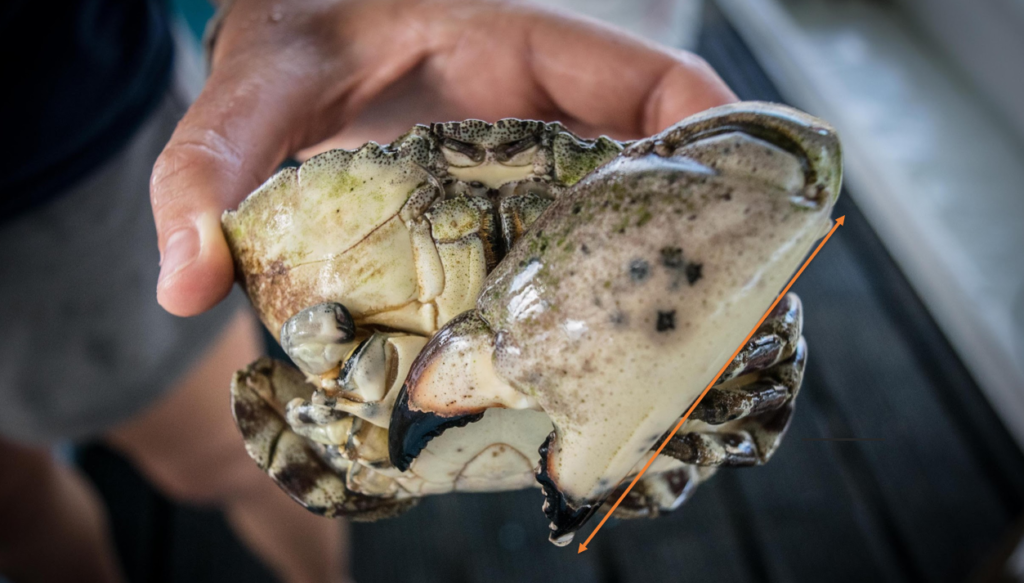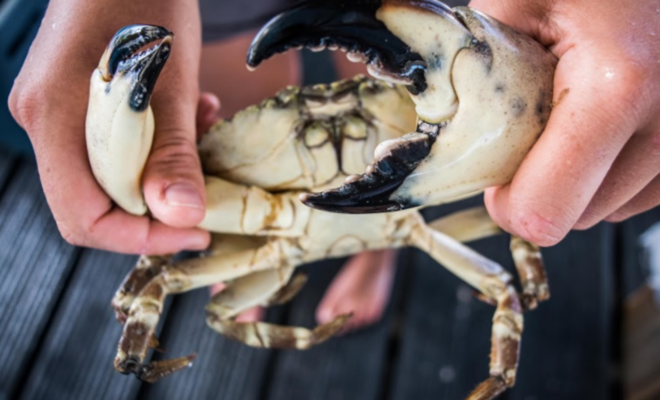Stone crabs are found throughout the Caribbean and tropical western Atlantic and are the target of a claw only fishery. Some of the largest stone crab claws come out of Bahamian waters, and the claws exported from the Bahamas make up a ‘colossal’ size class in US markets, a size that is rarely found in Florida waters anymore. And while you may not see their claws on offer at every dock, fish fry or restaurant, stone crabs are a growing fishery in The Bahamas. Much of the catch is exported to the USA at an estimated value of $3.1 million each year.
Currently, The Bahamas has stone crab fishing regulations in place outlined below:
- Minimum claw size 4 inches
- Closed season June 1 – October 15
- Illegal to harvest claws from an egg bearing female at any time

The crabs have two large claws, or “biters”, that can make up as much as 60% of their total body weight. These outsized limbs are incredibly strong as they are used to crush the hard shells of their mollusk prey, including things like clams and mussels. This is a claw-only fishery, meaning the claws are removed from the crab (if they are over the legal size requirement of 4 inches) and the living crab is returned to the sea. Stone crabs, like other crustaceans, can regrow claws that have been lost.
Because of this regeneration ability, this may seem like a truly sustainable fishery. The whole animal doesn’t have to be killed to be harvested (as with nearly every other form of animal protein) and they can even reenter the fishery once the claws regrow. At least, that’s how the theory goes. Unfortunately, the reality may be different as recent research has shown.
Current Claw Removal
Traditionally, fishers remove the claws by breaking them off at the base. Claw removal can cause excessive blood loss, especially if done improperly, resulting in the crab dying after it is released (crab ‘blood’ is actually called hemolymph). Research from Florida, where a large stone crab fishery also exists, has shown that anywhere from 30-60% of stone crabs may die after being harvested. And even if the crab survives claw removal, losing one or both of their claws may cause a shift in their diet to things that don’t need to be crushed, and may make them more likely to be eaten by a predator.
Sustaining the Fishery
After decades of heavy fishing pressure, the Florida stone crab fishery is showing signs of reduced catches and there is an increased concern over its sustainability. The commercial stone crab fishery in The Bahamas is much younger, and there are several regulations in place to help protect their populations as they are an important natural resource for the country. However, the establishment of best practices is important to ensure the sustainability of this fishery into the future. This includes practices such as only removing one claw, which has been shown to increase the chances of crab survival, as well as using proper handling and claw removal techniques during the harvest process.
New Sustainable Harvest Method
A lesser-known claw removal technique may also improve crab survival. Similar to a lizard dropping its tail when it feels threatened by a predator, crabs can shed their claws in a process called autotomy, or self-removal. Researchers at The Island School’s Cape Eleuthera Institute (CEI) are studying the effects of this alternative claw removal technique and are working in collaboration with commercial stone crab fishers on Eleuthera to host an information sharing and training meeting this June after the stone crab season closes. During the meeting, best practices will be discussed and findings from research projects will be shared to help collaboratively improve the sustainability of the Bahamian stone crab fishery.
If you are interested in attending, please reach out to Eric Schneider (242-821-0337 / ericschneider@islandschool.org) or Candice Brittain (candicebrittain@islandschool.org).
